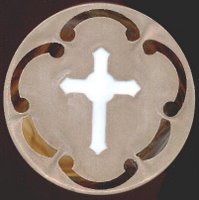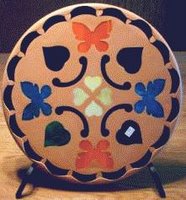Let me say right off the bat, I don’t use traditional concrete mix and chicken wire to make my stepping stones. There are several reasons:
• I’m into instant gratification, and concrete just takes too long to suit me.
• You have to buy two different grades of concrete: a nice, super fine grade for the top third or so of the stone, and a coarser grade for the bottom two thirds.
• Mixing concrete is like rocket science to me; you have to add just the right amounts of everything to get it right. Forget it! Life is short. Remember the instant gratification thing.
• You need to embed chicken wire between the two grades of concrete.
• Concrete comes in one color. You can add colorants, but it’s a mess and inconvenient.
Another product available, but which I’ve never used personally is FlashCrete. You can check it out at http://www.anythinginstainedglass.com/mosaics/mosaics7.htm
It doesn’t require a sealant, but if you want colors, you have to add powdered colorant.
My experience is with a product called DiamondCRETE. While I can’t seem to find written verification of this, I was told that DiamondCRETE withstands 600 pounds per square inch (600 psi). Here’s why I like it:
• It requires and comes in one grade
• You add approximately 2 ounces of water to every cup of DiamondCRETE to get a thick milkshake consistency
• It’s pre-colored and comes in a wide variety of shades
• You can thoroughly mix the colors to get additional shades, or you can mix less thoroughly and produce swirled effects.
It sets up quickly. Very quickly. In anywhere from one to three hours, you can pop your stone out of the mold and let it continue to dry.
DiamondCRETE comes in 10 and 25 pound boxes as well as 60 pound buckets or boxes. You can purchase it at various craft stores such as Hobby Lobby, although they normally only carry the 10 pound size. It is also available through mail order.
The DiamondCRETE web site is located at http://www.diamondcrete.net/
and contains a wealth of information including mixing instructions and tips, troubleshooting, etc.
The total amount of water and DiamondCRETE you use will be dependent on the size and shape of your mold. Amounts needed for various sizes and shapes are listed on the DiamondCRETE boxes. Expect to use anywhere from 10 to 18 cups of DiamondCRETE per average project.
Put on your rubber gloves and dust mask, and measure out the water you need in one bucket. Using a different (dry) measuring cup, measure the DiamondCRETE into another bucket. Then pour about 1/3 of the water into a third, smaller container. Hold this back to add as needed, and bear in mind that you may not need all of it.
Gradually add the DiamondCRETE into the remaining 2/3 of the water and mix thoroughly using a paint stick or your gloved hand. I prefer to use my hand because the mixture will be thick and maybe clumpy. You’ll be able to feel those clumps and break them up with your fingers. Keep adding the DiamondCRETE until it’s very dry and hard to mix. Then gradually begin to add that last third of the water that you set aside in the small container and continue mixing. Keep adding water until you reach that thick milkshake consistency. There is some variation in how each of the colors mixes. Some colors will take less liquid than you’ve saved back. Don’t worry. You don’t have to use all the water because once you get to that milkshake consistency, it’s adequate. Too much water will make the mix too runny, and that will produce a weak stone.
When you’ve got it just right, then mix it like crazy for several minutes – but no more than five. This causes some sort of magical chemical reaction in the DiamondCRETE that will make it work right. That’s about as scientific as I’ll get on the subject. You’ll actually start to feel some heat from this reaction, and when you do, it’s time to pour.
















